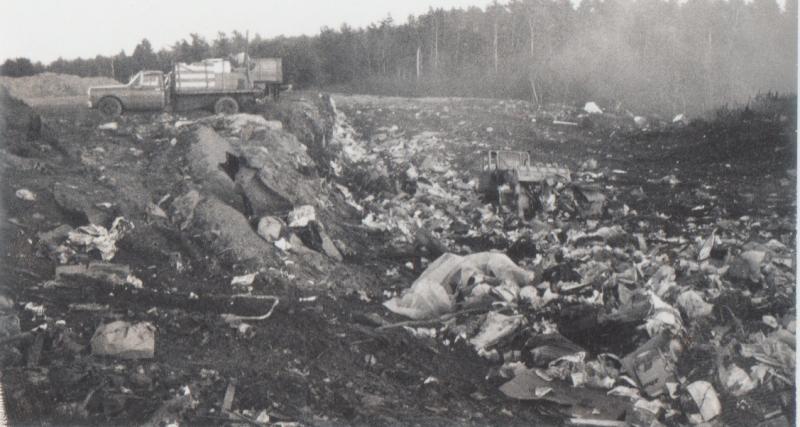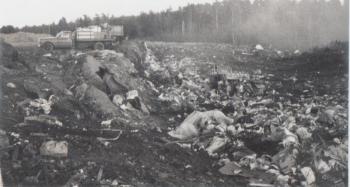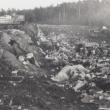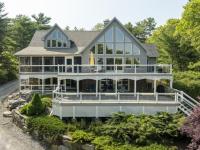Boothbay Region Dumps, Part I
I wrote these articles back in 2003 and rather than bring them up to date 19 years later, I thought a good portion of readers might enjoy reading the words from their old, but now gone, friends and neighbors who I consulted in writing this piece nearly 20 years ago.
It's always interesting to me to find out what people did before the modern age and all its conveniences. The ways of getting heat, light, water, and food have changed radically. Individuals now play nearly no role except for paying money and turning a valve or a thermostat with fingertips. Not too long ago those items were mostly provided by muscle power in lugging water, cutting wood and lugging it or coal and tending a fire, buying and lugging kerosene and candles, and growing and raising and making much of the consumed bread, meat and vegetables.
Personal Dumps and Overboard
Equally different is the amount of trash and how we get rid of it. We're all familiar with "bottle" dumps that are found on most old private home sites, often located just over a wall. And that was prevalent all over. Few people had much trash, so it was sufficient to simply move it far enough away from the house to not stumble over it, or to bury it in the yard in less rural areas. As Elliott Barlow said, "You didn't intend to take yourself and it any farther than you had to." Asa Tupper, a Boothbay Harbor native born in 1898, told me he buried trash in his small houselot garden, and he had no cans because his wife cooked everything from scratch.
Similarly, Gleason Gamage, in his 90s, said that at Cape Newagen when he was young, his family buried trash in the garden, and many people took it out fishing and threw it overboard. He also pointed out that a dump on the Cross Road, now built up with houses, went back quite a number of decades.
On Barters Island, Vincent Lewis, in his 80s, said that most people had personal dumps or they threw it off the Barters Island bridge by the store on Hodgdons Island, where there was a good current and depth. Those who threw it off the Knickerbocker bridge into shallow sluggish water didn't have the advantage of watching it disappear.
When Virginia Gamage, in her 90s, was young on Campbell Street in the Harbor, her family had an ash pile where the trash went. Virginia said she believed most people routinely threw trash off the footbridge. Mabel Brackett, in her 90s, said all her father's trash stayed on the property. Judge Brackett filled hollows in the yard with trash and covered them with dirt, killing two birds with one stone.
When Florence Barlow Haggett, in her 90s, was young her family had hens and pigs for any scraps, and they had a container to burn trash out back. And they might have used a neighborhood dump, as described below. Lester Barter, born 1906, said his family on Sea Street put their trash overboard at Mill Cove.
Neighborhood Dumps--Fishers Hill and the Meadow
I first learned a little about local Harbor dumps ten years ago when Lester Barter took me to some he remembered in the Harbor and some he'd heard about. According to his father, a fire pond on Howard Street once stretched east down to McKown Street. Eventually it was used as a dump and filled in; it's now the parking lot. He took me up to Fishers Hill and we looked over the old dump site there on the hillside trending away from the Harbor. He also took me to the upper part of the Meadow and showed me a dump there, in the little road just past the buildings Bobby Holmes has recently refurbished. Bobby cleaned up that dump.
Hospital, Congo Church
Margaret Orne Kelly of West Harbor, in her 80s, remembers that when she was young the front parking lot of the hospital was a very deep gully that was used by the hospital and neighbors as a dump, raising the level about 20 feet. The children who roamed the neighborhood would play there at times and would find fascinating objects such as hypodermics.
Mabel Brackett mentioned a neighborhood dump by the Congo church, and I learned more from the Gamages who live on Pear Street. When they moved there in 1942, the neighborhood dump was between their house and Florence Harrold's on School Street, and people from the upper part of the Harbor wheeled their trash to the site. It was located on what may have been a Central Maine Power right of way from the head of the Harbor where there was a substation some time ago. Elliot Barlow even remembers junk cars in that dump, though they were eventually removed. And the Gamages' cat cleaned out the rats, bringing trophies home for praise. One morning a three-member rat family was neatly laid out for Virginia and Gleason's delectation. With some gentle encouragement from the Harrolds and the Gamages--a picket fence and "no dumping" signs--eventually people stopped bringing trash there.
Next time: Part II





























